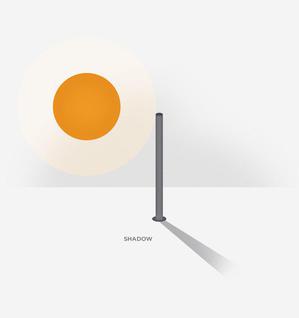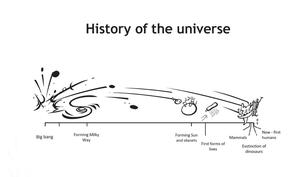Glossarbegriffe: Zeit
Description: Wir alle haben eine grundlegende Vorstellung davon, was Zeit ist: eine Abfolge von Ereignissen, eines nach dem anderen, von der Vergangenheit über die Gegenwart bis in die Zukunft. Wir können Zeit weder sehen, hören, berühren oder schmecken. Aber wir können sie messen - und das ist der Aspekt der Zeit, der in der Astronomie und in der Physik von Bedeutung ist.
Wir messen die Zeit, indem wir die Dauer eines Ereignisses mit der Dauer vergleichen, die wir mit einer Uhr (oder bei längeren Zeiträumen mit einem Kalender) messen. Früher wurden derartige Zeitmessungen über die Erdrotation definiert: Die Zeit, die die Erde gemessen an der Position der Sonne für eine volle Umdrehung braucht, legt die Länge eines Tages fest. Zusätzliche Zeiteinheiten basieren auf weiteren Unterteilungen: Ein Tag wird in 24 Stunden, jede Stunde in 60 Minuten und jede Minute in 60 Sekunden unterteilt.
Seit 1967 basiert die Definition der Zeit stattdessen auf der Dauer einer Sekunde, wie sie von einer Cäsium-133-Atomuhr gemessen wird ("SI-Sekunde"). Auf dieser Grundlage sind mehrere Zeitsysteme definiert, insbesondere die koordinierte Weltzeit (UTC), die weltweit in der amtlichen Zeitmessung verwendet wird, und das sogenannte julianische Datum und seine Varianten: Das julianische Datum wird in der Astronomie zur Tageszählung verwendet.
Einsteins spezielle Relativitätstheorie und allgemeine Relativitätstheorie haben gezeigt, dass die Zeit, die auf einer Uhr vergeht, sowohl von der Bewegung als auch vom Einfluss der Schwerkraft auf diese Uhr abhängt. Diese relativistischen Effekte müssen bei hochpräzisen Zeitmessungen berücksichtigt werden, wie z. B. bei den Messungen mit den Satelliten des Global Positioning System (GPS).
Zugehörige Glossarbegriffe:
See this term in other languages
Term and definition status: The original definition of this term in English have been approved by a research astronomer and a teacher The translation of this term and its definition is still awaiting approval
The OAE Multilingual Glossary is a project of the IAU Office of Astronomy for Education (OAE) in collaboration with the IAU Office of Astronomy Outreach (OAO). The terms and definitions were chosen, written and reviewed by a collective effort from the OAE, the OAE Centers and Nodes, the OAE National Astronomy Education Coordinators (NAECs) and other volunteers. You can find a full list of credits here. All glossary terms and their definitions are released under a Creative Commons CC BY-4.0 license and should be credited to "IAU OAE".
Related Activities
Sun’s Shadow
astroEDU educational activity (links to astroEDU website) Description: Why is the Sun's shadow so important?License: CC-BY-4.0 Creative Commons Namensnennung 4.0 International (CC BY 4.0) icons
Tags: Hands-on , Shadows Age Ranges: 6-8 , 8-10 , 10-12 , 12-14 , 14-16 Education Level: Informal , Middle School , Primary , Secondary Areas of Learning: Observation based , Social Research Costs: Medium Cost Duration: 1 day Group Size: Group Skills: Asking questions , Communicating information , Constructing explanations , Engaging in argument from evidenceDay and Night in the World
astroEDU educational activity (links to astroEDU website) Description: Compare diurnal and nocturnal animals and experiment with day and night.License: CC-BY-4.0 Creative Commons Namensnennung 4.0 International (CC BY 4.0) icons
Tags: Life , Model , Animals , Day and night Age Ranges: 6-8 , 8-10 Education Level: Primary Areas of Learning: Interactive Lecture , Modelling , Social Research Costs: Low Cost Duration: 1 hour Group Size: Group Skills: Asking questions , Constructing explanations , Developing and using models , Planning and carrying out investigationsWhat Is Time?
astroEDU educational activity (links to astroEDU website) Description: Build an hourglass to understand what time is and how it can be measured.License: CC-BY-4.0 Creative Commons Namensnennung 4.0 International (CC BY 4.0) icons
Tags: Hands-on , Measurement , Day and night , Measure , Instruments Age Ranges: 6-8 , 8-10 , 10-12 Education Level: Middle School , Primary Areas of Learning: Modelling , Problem-solving , Social Research Costs: Medium Cost Duration: 1 hour Group Size: Group Skills: Asking questions , Developing and using models , Planning and carrying out investigationsMaking a Sundial
astroEDU educational activity (links to astroEDU website) Description: Build a sundial and discover how time can be measured.License: CC-BY-4.0 Creative Commons Namensnennung 4.0 International (CC BY 4.0) icons
Tags: Hands-on , Measurement , Measure , History , Clocks Age Ranges: 6-8 , 8-10 , 10-12 Education Level: Middle School , Primary Areas of Learning: Modelling , Observation based , Social Research Costs: Medium Cost Duration: 1 hour Group Size: Group Skills: Analysing and interpreting data , Asking questions , Communicating information , Developing and using modelsHistory of the Universe
astroEDU educational activity (links to astroEDU website) Description: Build a timeline of the all Universe!License: CC-BY-4.0 Creative Commons Namensnennung 4.0 International (CC BY 4.0) icons
Tags: History , Timeline , Mathematics , Humans Age Ranges: 8-10 , 10-12 , 12-14 Education Level: Middle School , Primary Areas of Learning: Problem-solving , Social Research Costs: Low Cost Duration: 1 hour 30 mins Group Size: Group Skills: Asking questions , Communicating information , Developing and using models , Using mathematics and computational thinking












